Eric C. Sheninger's Blog, page 12
January 22, 2023
Imparting Value When It Comes to Change
I remember vividly as a young principal when I started to drink the “edtech” Kool-Aid many years ago. It represented a true turning point in how I thought about change in education. Up until this point, my thinking was relatively traditional and as such, so was the culture of my school. However, I was motivated like never before to move beyond the nearly impenetrable walls I had mentally constructed that had inhibited me from moving beyond my comfort zone until this point. It was now time to become a true leader and that required being honest about where not only I was but also the culture of my school.
When I first attempted to channel this excitement into a call to action, I failed miserably. Basically, all I did was talk about what “I” wanted to accomplish and what “I” thought was important when it came to the purposeful use of technology in the classroom as a catalyst to improve outcomes. After some deep internal and external reflection, I soon realized that I failed to help my staff see the value for themselves when it came to shifting their practice in new and innovative ways. Herein lies the reason that most change initiatives fail. If people don’t see the value in what they are being asked to do, the chances increase that they won’t get on board.
I learned an important lesson that still sticks with me today. Change for the sake of change is often a recipe for disaster. My role as a leader was to alleviate fear, mitigate risk, and create the conditions where my staff wanted to change for their own sake as well as that of their students. While research and data certainly play a pivotal role in showcasing the value of change efforts, the real key is to make everyone part of the solution. Leaders who do this strive to:
Create a shared visionEmpower peopleBuild capacityImprove outcomes
All of the above elements play a part in achieving collective efficacy, which is the belief that a group can work together effectively to achieve common goals. Some positive outcomes include improved group performance, increased motivation, greater resilience, and better problem-solving. Collective efficacy is hard to achieve without an initial sense of value in doing things differently.
Leaders need to be attuned to the fact that the world is rapidly evolving, something I discuss in detail in Digital Leadership. Abiding by the status quo doesn’t cut it, no matter where performance indicators reside. Herein lies a significant challenge when it comes to venturing down an innovative path. Organizations can become more efficient and effective by continuously looking for ways to improve processes and systems, but people need to understand the value from the beginning. Valuing change is critical because it helps to create a culture of continuous improvement and innovation within an organization. When people value change, they are more open to new ideas and approaches and more willing to embrace and adapt to change when necessary.
January 16, 2023
#EDvice: Closing Learning Gaps with Rotational Models
Education is still reeling from the impacts of COVID-19. The rapid shift to virtual learning was a necessity and, like always, educators rose to the occasion like they always do even though training in this area didn’t really exist at scale. A few years later, we are beginning to get an idea of the most pressing issue at hand, which is learning recovery. During coaching visits across the country, educators share the difficulty of having classrooms of students where the majority are at different grade levels. So how do we begin to address this issue?
Knowing where kids are and then developing strategies to meet their respective needs is one of the most effective ways to close learning gaps post-pandemic. While the challenge is real, rotational models can stem the tide. In this piece of #EDvice I unpack this strategy and how it can be easily implemented in K-12 classrooms.
Success using rotational models relies on maximizing available class time, understanding sound pedagogy, and leveraging actionable data. Below are some resources I created to help educators with effective implementation.
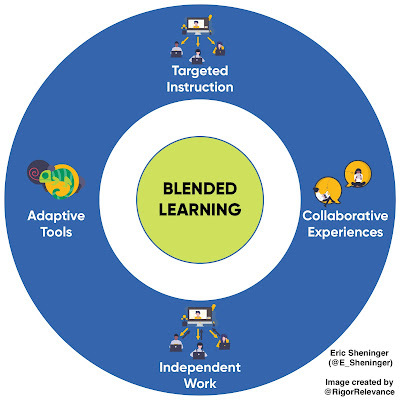
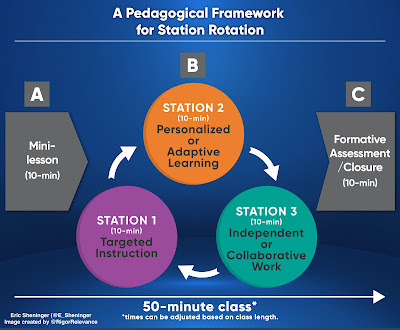 Read the post
Read the post
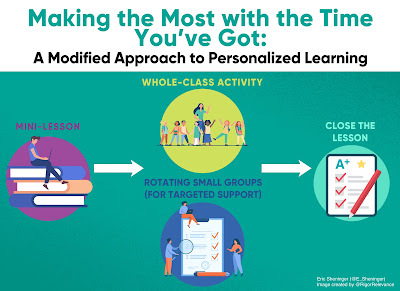 Read the post
Read the postAt the International Center for Leadership in Education (ICLE), we have developed research and evidence-based professional learning solutions to scale personalized strategies that are integral for learner success in a post-pandemic world. If you are interested in learning more, drop your email in the comments section.
January 8, 2023
Self-Regulation in the Personalized Classroom
One of the best and most gratifying aspects of my job is getting into classrooms and providing feedback to leaders, who, in turn, help their teachers grow. Most of my blog ideas materialize during these times of bliss. Without this practical lens, I don’t think I would be able to write anything of value. Over the years, the state of Utah has provided me with a plethora of opportunities to work with schools on Personalized Competency-Based Learning (PCBL). Not only is this area of focus dear to my heart, but there are always various nuances that can be explored in greater detail.
I am always fascinated by how high-agency strategies can unlock the potential of learners. In particular, I see a clear connection to how path and pace can promote self-regulation, a competency that is important for students in school and all of us in our professional lives. Research provides a sound rationale for its importance and impact on learners. An article by Y. B. Chung and Mantak Yuen (2011) in the Journal of Invitational Theory and Practice states the following:
In the context of schools, self-regulation is evident not only when students control their own behavior in and out of the classroom (self-discipline or self-control) but also when, during lessons, they are able to set their own goals, plan appropriate strategies for achieving these goals, monitor, evaluate and adapt their own actions, and control their effective use of available learning time and resources (Ormrod, 2010). A large body of empirical evidence suggests that self-regulated learners are more effective, confident, resourceful, and persistent in learning (Pintrich, 1995; Schunk & Zimmerman, 1994; Winne & Hadwin, 1998; Zimmerman & Campillo, 2003).
With the right conditions in place, learners who effectively self-regulate can:
Establish goals and applicable strategies to accomplish themEffectively monitor progressReflect on performance to self-evaluate
A recent coaching cycle at Quest Academy Junior High School unearthed numerous instances where teachers had integrated personalized strategies to promote self-regulation. In Shawn Berry’s 8th-grade math class, I observed students writing down individual learning goals for the lesson based on unpacked standards in the form of learning targets. Once done, they added each of these to a whiteboard. After reflecting on this, I reached out to principal Nicki Slaugh and asked if she could get some more details from Shawn. Here is what she provided:
In a self-paced classroom, it's essential to help students manage their time. I noticed my eighth graders were struggling to stay focused and on target in our self-paced math program. I got the idea for them to create a specific to-do list for the 57 minutes they are in the classroom. The first 5 minutes are for a spiral review or math talk question and we need 1 minute at the end for closure. That left 51 minutes to organize, so I decided to divide that into 17-minute sections.
Each student creates a to-do list based on three sets of 17 minutes. I use a timer on the TV that visually counts down and has an alarm. In the beginning, we discussed how to make sure the tasks they chose for their lists were reasonable to finish in 17 minutes. Some students were choosing tasks that were too short or too long. At the end of class, the students add their post-it to our chart on the class whiteboard to show how many of their tasks they finished.
Since starting this, more students have felt success during class and are able to stay on task. Some students have realized future tasks are dependent on the outcome of their first task, so they either make a plan A and plan B list or complete their to-do list after completing their first task. I love seeing 13- and 14-year-olds learn how to manage their time using short-term deadlines. The academic deadlines for their course are sometimes hard to conceptualize because they take weeks to accomplish. This is a skill they will definitely need in their future!
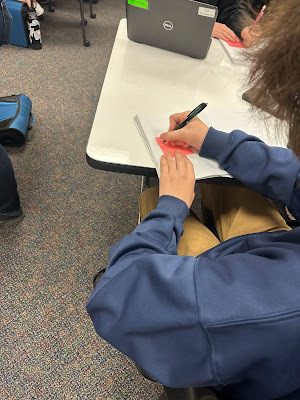
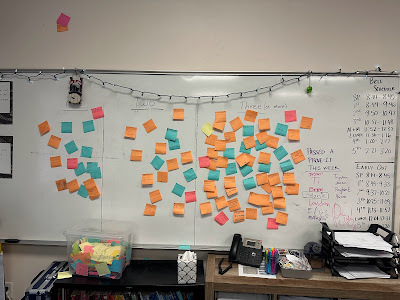
Self-regulation is a hallmark of personalized learning. Students are more prone to own their learning as they are taking proactive steps to identify where they are, where they want to be, and what is needed to succeed. In life, this might be the most critical competency that educators can cultivate in the classroom.
Ormrod, J. E. (2010). Educational psychology: developing learners (7th ed.). Upper Saddle River, NJ: Pearson-Prentice Hall.
Pintrich, P. R. (1995). Understanding self-regulated learning. San Francisco, CA, Jossey-Bass.
Schunk, D. H., & Zimmerman, B. J. (1994). Self-regulation of learning and performance: Issues and educational applications. Hillsdale, NJ: Erlbaum.
Winne, P. H., & Hadwin, A. F. (1998). Studying as self-regulated learning. In D. J. Hacker, J. Dunlosky, & A. C. Graesser (Eds.) Metacognition in educational theory and practice (pp. 279-306). Hillsdale, NJ: Erlbaum.
Zimmerman, B. J., & Campillo, M. (2003). Motivating self-regulated problem solvers. In J. E. Davidson & R. J. Sternberg (Eds.) The nature of problem solving (pp. 239), New York: Cambridge University Press.
December 18, 2022
Top Posts of 2022
With each passing year, I am always amazed that I continue to blog with consistency. It has become much more challenging, which is why I made the decision to move to a bi-monthly writing schedule. In a recent post, I shared my rationale. Basically, I am running out of unique topics and angles to explore so I don’t want to run the risk of becoming redundant. In some cases, this has already happened already, which is even more reason to put time and effort into my emerging video project called #EDvice. I plan to pick back up with this series early in 2023.

While many of my posts highlighted successes in current coaching projects, I tried to focus my efforts on expanding concepts presented in Disruptive Thinking in Our Classrooms. No matter how “evergreen” a book, the fact of the matter is that things change, or new perspectives are gleaned. By evergreen I mean that the content withstands the test of time. Unlike the days when there was no Internet, anyone can provide deeper context or supporting examples to supplement and piece of traditional written work. If you want to see these posts, I have curated them on this Pinterest board. If you are interested in a book study after the holidays there is a comprehensive study guide and an impressive bulk order discount through ConnectEDD Publishing (email info@connecteddpublishing.com).
Below are my top posts from 2022. There is a nice mix of concepts including personalization, educational technology, leadership, and school culture. As I did last year, I am including a hyperlink and the related image. I wish you all a happy and safe holiday season. Here’s to an amazing 2023!
Moving Beyond SAMR with the Rigor Relevance Framework


Your Ticket to Move Effective Lessons

Supporting and Rewarding Teachers with Time

The Ever-Evolving Leadership Lens

December 12, 2022
#EDvice: Practical Strategies in 90 Seconds or Less
I never saw myself as a writer until I started blogging back in March 2010. It all began with goal setting for the Google Teacher Academy for Administrators, and I haven’t looked back. Consistency has been vital for me, as I have published a post every week since. Therein lies the dilemma I am currently facing. The struggle is real in my case when it comes to finding new topics to blog about or adding an innovative spin to already-prevalent concepts. I find myself spending an immense amount of time just to churn out 500 words. Upon reflection, this might be one sign to change things up a bit. The time has come for me to challenge my personal status quo.
In a world where multimedia content is virtually at everyone’s fingertips, written content that dives into concepts and strategies might not have the same impact as it once did. Attention spans are not what they used to be, and this is something we all need to be cognizant of when sharing ideas. In the digital age, brevity is virtue when it comes to processing and implementing strategies. Upon further reflection—and so I can grow—I decided to dedicate more time to developing short video clips in lieu of blogging each week. I will not stop writing regularly because I still see immense value in the process, but I plan to change my routine and shift to a bi-weekly schedule. Every other week I will share a simple, practical strategy that educators can use right away *in 90 seconds or less* called #EDvice. I have to give credit to my ICLE colleague Matt Thouin for coming up with the hashtag, which I feel is quite catchy.

Leveraging my current experiences in classrooms, schools, and districts working with educators, my plan is to articulate one strategy from the following three-step perspective:
Why is this strategy important?How can it be readily implemented?What could it look like in practice?For my first clip, I decided to share some advice on developing choice boards. (Special thanks to Dan MacCracken, another ICLE colleague, who edited and tweaked my raw video.) During a recent coaching visit with Quest Academy Junior High School, l I observed teachers readily implementing strategies that we’d collaborated on over the course of the year. Hats off to Principal Nicki Slaugh for following through on the feedback I provide after each visit. The video below shares a practical strategy educators can use when developing effective choice boards:
While I’d dabbled in video content in the past, I believe that returning to this medium now is coming at the right time for me—and hopefully it is for you, too. Ultimately, I want to expand the opportunities for us to connect around our daily, meaningful work and amplify conversations between educators to elevate our practice one behavior at a time. On that note, I invite you to send me your own ideas, questions, and wonderings for #EDvice—what’s on your mind? I look forward to hearing from you—thanks, as always.
December 4, 2022
Creating a New Status Quo
Blink and there is a new iPhone on the market. I feel like I just got the 13 model yesterday, but the reality is that I came into possession of it in 2019. Thanks to a very gracious promotion, I recently upgraded to the 14 plus. The improved camera alone makes this new model work the investment. While I am thrilled with the new device, I know full well that the 15 will be out sometime next year and has probably already been developed. Technology companies like Apple live and thrive in a cutting-edge world. They are constantly innovating with a purpose, whether we agree with it or not.
Innovative companies don’t dwell on the past. On the contrary, they seem to have one eye on the present and another on the future. They foresee both what the world needs and what consumers want to develop solutions that improve some aspects that both parties hold dear. If companies continued to do what they always did, they would become irrelevant in a rapidly changing world. The status quo is something that isn’t a part of their DNA and for a good reason.
Now let’s apply the same concepts of innovation and transformation in response to a disruptive world of education. While no one can deny that some exciting changes have taken place in schools across the globe, the reality is that traditional schooling remains firmly in place. More often than not, you will see kids seated at desks in rows, a great deal of direct instruction, bells to signify transitions, technology being used as a substitute, and everyone doing the same thing at the same time the same way. The question we should all be asking is why traditional schooling is still perpetuated in light of what we experienced and learned during the pandemic. While there is no silver bullet, we can ill afford to sustain systems that prepare learners for a world that no longer exists.
I shared the following in Disruptive Thinking:
We live in a world dominated by exponential change that has and will continue to fundamentally impact all facets of society. Disruption is no longer a buzzword, but a reality. To best prepare our learners to flourish now and in the future, the key is to help develop them into dis- ruptive thinkers who thrive in a disruptive world. If we are to develop students who think disruptively, we must examine and reflect on our current teaching and learning practices.
Below is an attempt to visualize my thoughts. Schooling, in my opinion, is what is done to students. Education, on the other hand, is what they need to thrive in a complex and unpredictable world ripe with opportunity, with the most critical component being personalization.

One might think so much more can be included as part of an evolved education. I completely agree. When looking at the components I included, it can be inferred that the tasks promote cognitive flexibility, include the purposeful use of tech, and provide authentic learning experiences (i.e., academy programs, internships, capstone projects). However, when it is all said and done, an evolved education can consist of any elements that future-proof learning for all kids in ways that prepare them for anything. Once these become embedded in school culture and scaled, a new status quo will take hold. In a disruptive world, this is what our students both need and deserve.

November 27, 2022
What Example Do You Set?
While there are some exceptions, most people do not like to be told what to do, especially when it comes to change. Not only does this often lead to resentment, but it can also inhibit people from doing their best work. I am sure many of us can recount numerous instances during our careers when directives have been leveled down by a leader(s). We end up following through with them in many cases because we are subordinate instead of empowered. The latter drives sustainable change leading to transformation at scale. Isn’t that what we all want?
I shared the following in Digital Leadership:
Leadership is not about telling people what to do but instead taking them where they need to be. Setting an example through your own practice illustrates to others that change is a shared endeavor. It is about the collective, where a title, position, and power don’t give someone a pass. When it all is said and done, leadership is about action, not talk and opinion (or memos and emails in my example). Setting an example and modeling is the first step. The next is a combination of support, accountability, and evidence that leads to efficacy. When everyone sees how the change(s) actually improves teaching, learning, and leadership, the path to sustainability starts.

 Image credit
Image creditThe images above tell a powerful story and many of us have seen them in various iterations. Just because you have a title doesn’t mean you are a leader. Motivating and inspiring the masses to be a part of something where there is a shared belief in the endeavor relies on being part of the solution. While telling, dictating, or bossing people might invoke some short-term results, lasting change materializes when the leader sets the example. Modeling is a powerful strategy. However, rolling up your sleeves and doing the work side-by-side with your people in certain situations will pay dividends time and time again. No matter which path you choose, here are some ideas to consider:
Teach a classFacilitate professional learningParticipate in your own PLC with staffCreate pathways for staff to provide you with routine feedbackWrite curriculumCurate and share evidence of how your work impacts outcomesWhere do you see an opportunity to set an example? What would you add to the list above? The bottom line is as simple as it is profound. Don’t ask others to do what you haven’t done or are unwilling to do yourself.
November 20, 2022
Developing Resilience in Learners
The pandemic leveled down an array of lessons that should pave the way for future success. One that sticks out to me as the most critical is how resilience got us through one of the most disruptive events we have ever experienced. Adversity, like never before, compelled us to not only change but also to persevere in the face of countless unknowns. While the path was fraught with obstacles, we learned to overcome them together through innovative means. Herein lies the essence of reliance and how important it is in a world that will only become more disruptive.
Since the impact of this quality is relatively straightforward, it is critical that schools cultivate it in learners of today and tomorrow. Marilyn Price Mitchell shared the following in an article for Edutopia:
Research has since established resilience as essential for human thriving and an ability necessary for the development of healthy, adaptable young people. It's what enables children to emerge from challenging experiences with a positive sense of themselves and their futures. Children who develop resilience are better able to face disappointment, learn from failure, cope with loss, and adapt to change. We recognize resilience in children when we observe their determination, grit, and perseverance to tackle problems and cope with the emotional challenges of school and life.
Here are some ways to develop resilience in learners:
Develop tasks that promote cognitive flexibilityCreate a culture of empathyAllow the solving of real-world problems Prioritize social-emotional learningUse failure as a springboard to growFoster gratitude in and out of the classroomTeach conflict resolution Provide opportunities for self-regulation Balance collaboration and independenceModel coping strategies
One of the best ways to develop resilience in learners is to empower them to be disruptive thinkers, which I define as the ability to replace conventional ideas with innovative solutions to authentic problems. An array of strategies can be used, such as problem and project-based learning, performance tasks, personalization, independent open courseware studies, internships, and capstone experiences. While these ideas represent larger endeavors, resilience can be nurtured every day in the classroom using two means that I discuss in detail in Disruptive Thinking in Our Classrooms:
Moving to Quad D using the Rigor Relevance FrameworkGetting students into the learning pit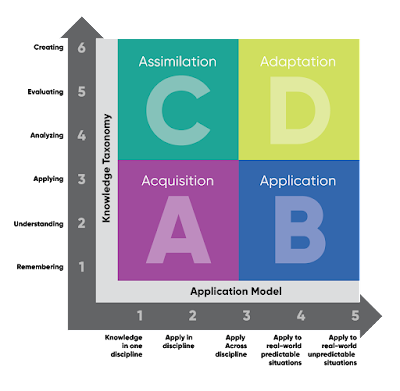
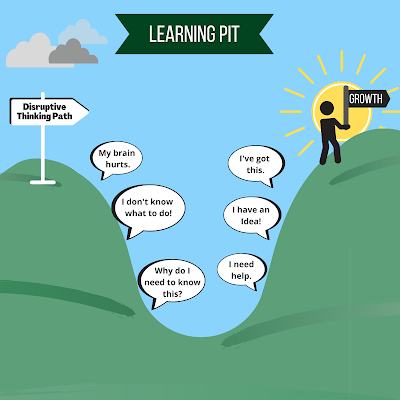
The images above illustrate how lesson components such as questions, tasks, and assessments can be constructed in ways to develop resilience in all learners. Ultimately, they will be better equipped to deal with disruptive forces that are sure to materialize.
November 13, 2022
Are You Juggling or Leading?
All leaders most likely view themselves as jugglers. Who could blame them when there are always multiple areas to address and the fact that the buck stops with them when it comes to making big decisions? Here are just a few:
AccountabilityMoraleMeetingsProfessional learningStakeholdersAchievementBudgetCrisesThe act of juggling requires concentration and focus. If you place all your attention on one ball, the chances of keeping the rest in the air are very slim. If you watch any juggler, you will see that person looking straight ahead. The reason for this is to veer away from focusing on the movement of each individual ball, with the goal being to keep them all in the air. Basically, a juggler does not focus on the balls as separate entities but instead as a whole.
It is natural to want to be and do everything as a leader. While the intention is positive, it is difficult, if not impossible, to put the needed effort into multiple moving parts. Instead, the rule of thumb should be to do one thing exceptionally well before dedicating time and energy elsewhere. The question that then needs to be answered is, are you juggling or leading? The best leaders de-emphasize multitasking and attempting to keep everything in the air. They instead clearly visualize the most pressing and vital ball and prioritize one thing at a time. Juggling is secondary, while the ball in front of them is primary.

It is hard to lead if you are constantly juggling. Consider the following to help keep your eye on the ball:
Honesty is the best policy. Know what you can handle in an effort to avoid stress, burnout, or things falling through the cracks. Make responsibilities clear. Think about what is needed in terms of time and resources. Leverage the power of delegation to empower others to focus on and attend to balls that are constantly in the air. Everything needs to be clarified. Prioritize to ensure success. Don’t shy away from dumping non-essential items. Seek advice. There is no reason to go at it alone. Be sure to elicit the counsel of those you trust. Plan accordingly. Never discount the importance of a strategic plan that takes into account all the elements listed above.If you want to be a juggler, keep that as a hobby. As a leader, zero in on the ball that is of the utmost importance to help you move change forward, support and empower your staff, and become the best iteration of yourself.
November 6, 2022
The 3 C’s to Survive and Thrive in Disruptive Times
We blink, and things change. While disruption is not new in any sense, it is happening at a more frenetic pace for a variety of reasons. I shared the following in Disruptive Thinking:
With the exponential rate of change taking place in society, it is exciting to think about what the future may hold, despite many unknowns. However, we know that the future will be vastly different than what we are currently experiencing and that these changes will dramatically impact workforce expectations.
Empowering our learners to think critically and solve real-world problems must be a cornerstone of our mission as educators. However, lifelong learning is a must for all of us, not just the kids we serve.
Disruption, in the eyes of many, has a negative connotation and leaves people frustrated and afraid. It can also push others outside their comfort zones. No matter the impact, the aftermath of disruptive events can set the stage for innovative change by focusing on the “3 C’s” – convalesce, conceptualize, create.

Convalesce
Recovery is often needed after disruptive events, which was clearly evident in the aftermath of the COVID-19 pandemic. It can also occur when we experience any exponential change, as we see with advances in technology. Support is imperative, but also there is a need to ask the right questions so that lessons learned can pave the way to develop ways to improve teaching, learning, and leadership that lead to better outcomes for all. Consider the following as you convalesce in the face of disruption:
How has disruption impacted our practice both in positive and negative ways?Why is it important to take action now to improve practice? What happens if we don’t?What additional information or support is needed?Leadership using an empathetic lens is critical to any recovery effort. A clear vision and plan are needed in addition to modeling the appropriate attitudes and behaviors to make difficult decisions. Equally instrumental is the ability of educators to reflect on the effectiveness of current practices and look for opportunities to grow. No matter your role, convalescing in disruptive times requires agility, improvising, collaboration, and problem-solving.
Conceptualize
Experiences, both good and bad, set the stage to determine appropriate action. In the age of disruption, convalescing often provides us with innovative ideas that can lead to positive change. The challenge is how to move these forward in ways that lead to a better normal. Conceptualizing means developing a practical way to implement an idea. It is not enough to simply have the idea as they are a dime a dozen. To conceptualize, educators must develop models of how such an idea might be made manifest itself into changes in practice. A sound plan of attack is crucial, or else the idea will fizzle.
Questions are a powerful tool in the conceptualization process. They can be kept simple enough to spark needed inquiry while helping develop the necessary context to transition an idea into reality. Here are some to consider:
Why is this idea needed or beneficial?How will this idea improve professional practice and outcomes?What will tell us whether or not the ideas were successfully implemented?Create
In my mind, this is the fun part. Disruption affords all of us the opportunity to take calculated risks in an effort to create a better way to teach, learn and lead. The first two C’s set the stage for actions that have the potential to radically transform our practice by seizing upon lessons learned through adversity. It is easy to brainstorm ideas and mentally envision how they will pan out over time. The difficulty is moving them through action. Below I offer a few ideas, but these only scratch the surface. Consider creating a:
lesson that infuses high-agency strategies (voice, choice, path, pace, place) not currently being used.opportunity for students to use technology in a purposeful way aligned to effective Tier 1 instructionstrategy to use data in the classroomvision for personalization in your school or districtvirtual option for studentsplan to afford teachers more time to learnprocess that results in high-functioning PLCsWhere do you see an opportunity to create better opportunities for those you serve?
Any idea that makes it to the creation stage must also be ready to implement, reflect, and revise as needed. Disruption can be a force for good with the right mindset and plan. When an opportunity arises, no matter the form, be ready to pounce.



